This is the shutter of our front door which is left in the open position practically all the time. However, my husband has a tendency to glance behind it when he passes by.
He did that on the 14 March last year and found a bat clasping onto the wall behind the shutter.
It was a bit of a change from the usual lizards that hide there! He stayed there for a few days but I have no idea what kind of bat he is.
Today (21.2.2014) there was another bat. This time on the shutter itself.
Black bats are difficult to photograph but at least he stayed still.
Looking closer he has got a cute face.
Is he trying to tell me something here?
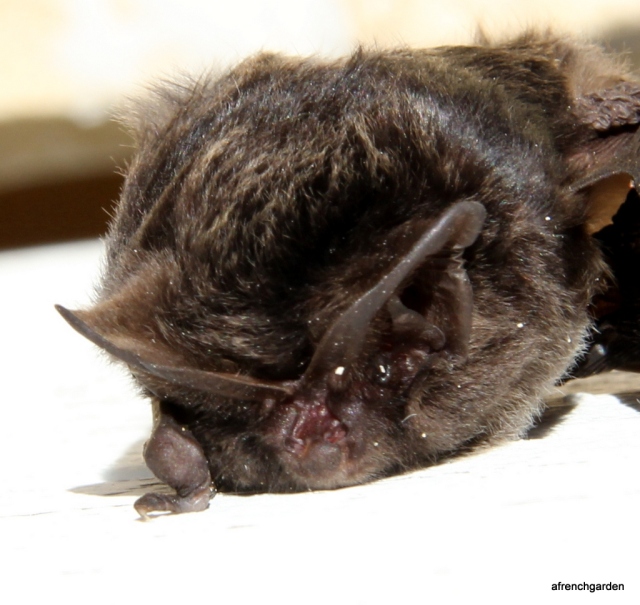 I noticed that he had a strange indentation on the outside of his ear flap and I wondered if it had been bitten. When I tried to identify him I saw a picture of a Barbastelle bat (Barbastella barbastellus) that had the same marking on the ear. Can anyone help out with an identification?
I noticed that he had a strange indentation on the outside of his ear flap and I wondered if it had been bitten. When I tried to identify him I saw a picture of a Barbastelle bat (Barbastella barbastellus) that had the same marking on the ear. Can anyone help out with an identification?
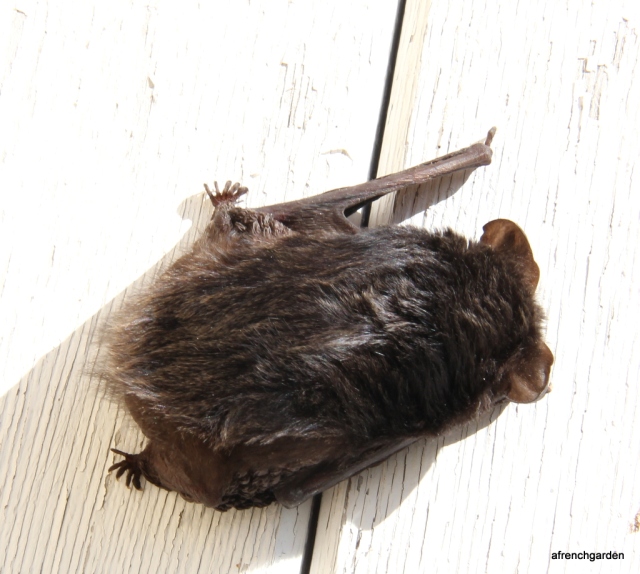 He measures 6 centimetres from front to back and has an incredibly furry coat. He has five toes – just like us!
He measures 6 centimetres from front to back and has an incredibly furry coat. He has five toes – just like us!
I don’t think our last year’s bat is the same species so he still stays an unidentified visitor.
I’ve put a watermark on these photographs. Do you think it is pretentious?


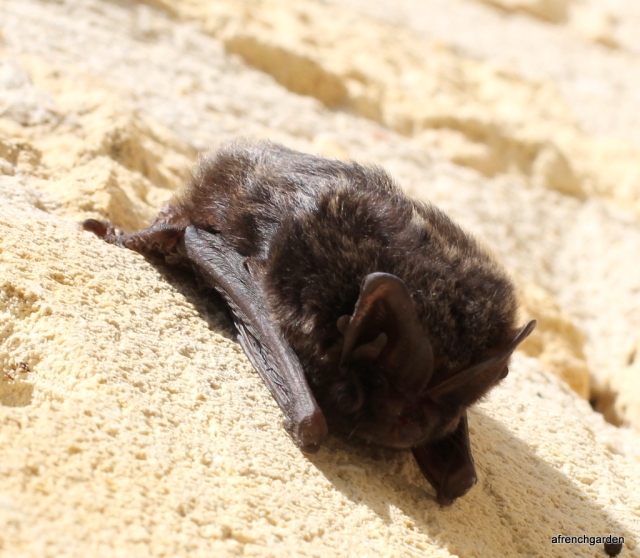
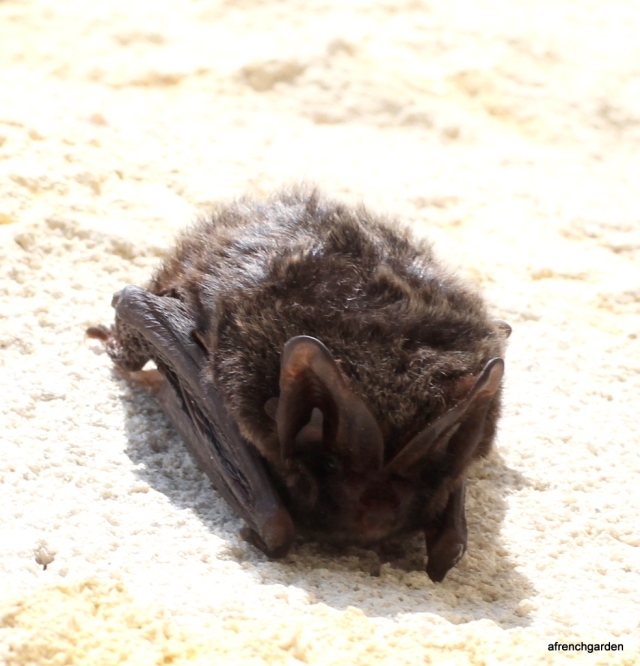
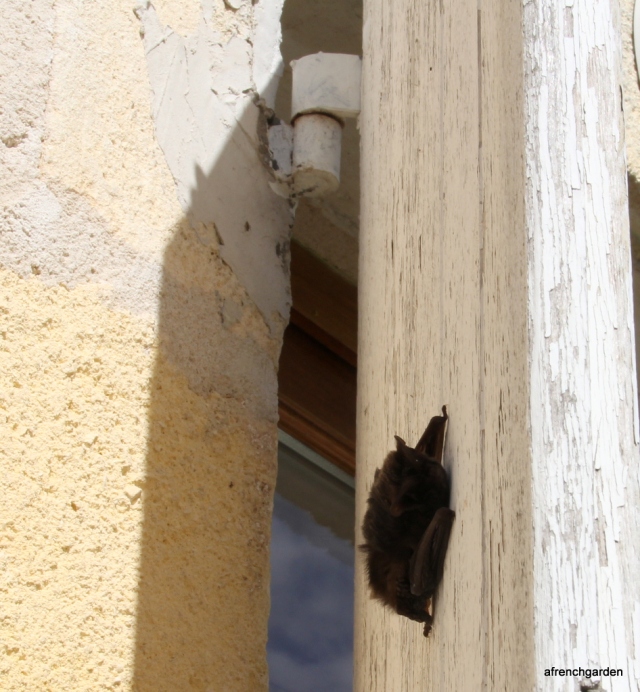

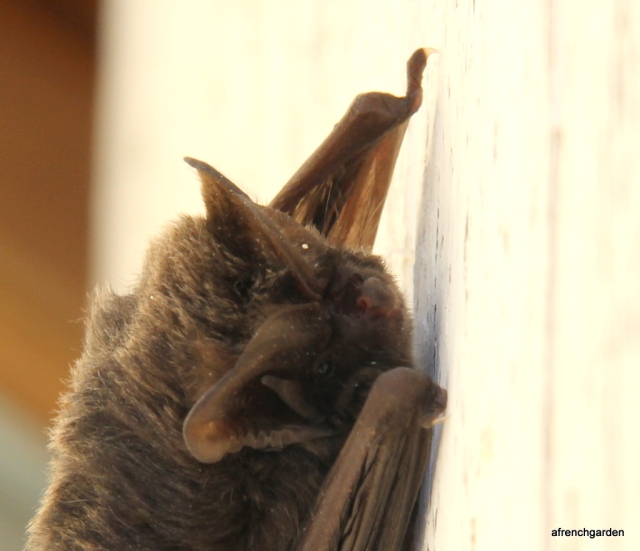

While not a great chance, but are you concerned with rabies? What little I know of bats, they are not diurnal unless something’s wrong.
Then again, as I said, I’m not an expert.
As for the watermark, not pretentious, and the one you have is a bit small. I’m sure you’ve noticed mine, and I also Digimarc the images so that I have a chance of finding out if anyone is copying and passing them off without my permission or giving me credit.
Lots of unscrupulous people out there.
LikeLike
I think that behind the wooden shutter is quite a good day roost for a passing bat, dark and usually peaceful. Thanks for the advice. Amelia
LikeLike
I don’t think putting a watermark is pretentious , I do on all mine mainly because I enter some in competitions, But I’m happy for folk to copy them …
LikeLike
I’m happy for people to use mine too. I was a bit surprised that they turn up on Google images, though.
LikeLike
yes it seems anything we post these days seems to get about abit
LikeLike
I was also going to mention the rabies aspect , one of the uk’s top bat experts died of rabies after forgetting to wear gloves while handling a bat.
LikeLike
Good point but I did not want to touch him to scare him and generally I try to disturb any wildlife as little as possible. Amelia
LikeLike
It’s lovely to have bat visitors. Though not to handle, but just to capture an image, I think is not unsafe. And nor is it pretentious to watermark your photos. They are your property, though you are generous enough to share them. It’s wise to protect one’s rights.
LikeLike
I felt I had disturbed him enough rudely interrupting his daytime sleep, I was not going to handle him. Thanks for positive comment. Amelia
LikeLike
I think he’s adorable !! I wish we had some here…
LikeLike
It’s nice to get a close up peep at wild animals even if it isn’t everyday. Amelia
LikeLike
I think they are both Barbastelles because the ears meet above the head. The only other bat that has that character is the Long-eared, and the ears don’t look long enough to me on the first one. The second one shows another character for Barbastelles, which is the virtually black pelt with pale tips to the hairs. The size is right too.
With regard to rabies: France has been declared officially rabies free for some years except for flying mammals (ie bats) and no one has died from rabies for decades in France. There was case in France this winter of a stray kitten with rabies and of a dead bat with one of the rabies like viruses. There have also been cases of dogs (usually about one or two a year) all of which have been animals illegally imported, usually from North Africa.
You should always handle bats with gloves just in case and be aware that if they excrete anything on to you (saliva, urine, faeces) you are at risk if you ingest it or it gets into a wound. Even if you don’t get rabies you could get septicaemia (a school friend in Australia has just lost all his toes as a result of an encounter with a fruit bat). Bats are fully protected, so you should not be handling them or disturbing them unless it is an emergency. Your local licenced bat workers are always happy to come out and give advice or assistance and can be contacted via any of the well known nature conservation organisations eg the LPO or the Conservatoire.
If you feel you have been exposed to rabies so long as you get the vaccination shot before symptoms develop you will be fine. You have at least 48 hours to get medical attention — it’s not like snakebite. However, once symptoms develop rabies is always fatal.
There — that’s cheered you up no end, hasn’t it 🙂
LikeLike
I must be honest and admit I hadn’t thought about rabies but I had no intention of handling him anyway. It would be still better to be over cautious, though, if the event presents itself. Now I understand the risks more clearly. Thanks for the ID – I had a feeling you might know. The first bat was not a long-eared. A friend saw the first one and we hesitated over the Barbastelle but dismissed it as it is not so common. I would imagine that there is a roost of Barbastelle near here. Amelia
LikeLike
I’m a big fan of bats, i’d love to see one so closely in the day time.
LikeLike
It is interesting to see them close up. He is not there this morning. Amelia
LikeLike
You have such wildlife in your garden! Gorgeous little critter. I can’t imagine why watermarking your images could be considered pretentious. Cautious, yes, but not pretentious surely. What a curious idea!
LikeLike
Thanks for the comment. I don’t mind them being used but I’ve seen them in Google images which just goes to show that you should be cautious about what you find on the Internet because I do not hold myself out to be an expert I’m just making a photographic story of my garden and surrounds. Amelia
LikeLike
I don’t know bats so I can’t help with an identification, but I do know that the do the same thing here. Shutters must be a favorite the world over.
I don’t think there is anything wrong with marking your own property.
LikeLike
That’s interesting that shutters are a favourite place for them to roost. You see, in the UK there are virtually no shutters. Try explaining that to French people! “But what do you do when you go to bed at night?” they say. Thanks for the the reply, also. Amelia
LikeLike
That’s interesting. I thought those little thatched cottages always had shutters. Obviously, I haven’t been paying attention.
LikeLike
Imagination is a great thing. I’ve never seen a thatched cottage with shutters. You do know not many people live in thatched cottages in the U.K.? I was really meaning in normal homes. Thatched cottages are rare and very expensive. You can imagine how much you pay out every year in fire insurance alone.
LikeLike
I found one of my bee photos on another web site. I mentioned it to them and gave them a “copyrighted” photo which they graciously swapped out. How does the watermark work. I didn’t see it on your photos. Does it only show up when the photo is copied and ‘pasted?’
LikeLike
Like you, I would only prefer my work to be acknowledged, I am happy if people use it, especially for educational purposes. I am very keen on people realising that there are a lot more beautiful, important bees out there apart from honey bees.
I’ve only used it on this last post as I am not a photographer and I do not profess to be one. Thus I felt that using the watermark might seem silly. The consensus seems to be pro watermark so I will keep it.
I use Picassa to process my pictures which is a free down load. There is a box I can add a watermark when I export my finished, cropped and tidied image. In this last post there is a “afrenchgarden” in the bottom right hand side. Amelia
LikeLike
Could be an evil look..? Eyeing up your neck for a snack. Or is that Transylvania, not rural France?
LikeLike
I must admit, in my innocence, I did not think he fancied me as a snack. I think we have to give him the benefit of the doubt. He’s not here today so he cannot have approved of the attention. Amelia
LikeLike
Quite a find, I wouldn’t have thought about the rabies so if I ever find one it will be a warning to me now. Not pretentious at all.
LikeLike
Thanks for the reply, noted. I think it is wise to take precautions with all wild animals but it isn’t always the first thing that comes to mind.
LikeLike
How delightful to find this little creature attached to your house/shutter. I don’t know much about bats except they are often given a bad rap in the popular imagination. I read on this site http://www.cornwall-batgroup.co.uk/barbastelle.htm that it is the male barbastelle which is solitary ( I was wondering why the bat was alone 🙂 ) When you are recording bees and wildlife so expertly, I think you are completely justified in putting a watermark on your photos.
LikeLike
Thank you for the link it is an interesting site for information for me. Thanks also for the reply which I note.
LikeLike
Great observation of a quite rare bat, and you’re spot on: it’s a barbastelle (Barbastellus barbastella):
http://www.inaturalist.org/taxa/40581
http://www.inaturalist.org/taxa/40581#taxon_range
We would welcome your observation at iNaturalist – in fact not only the bat observations, but any observation of living things that you would like to share (and get feed-back on identifications):
http://www.inaturalist.org
You will retain full control of your copyright there!
Cheers, Jakob
LikeLike
Thank you so much for confirming the observation. I am especially interested in bees but I was unaware of the inaturalist site. It looks a very interesting site and it covers France. I really appreciate the help I receive through my blog. I am trying to learn more about bees and I have started another blog “Bees in a French Garden” to link with people with a similar interest. However, I do not think bees are so well loved or studied as mammals. I might be wrong but this is the impression I get. Thanks again for your help. Amelia
LikeLike
Hi Amelia, you’re most welcome! iNaturalist is a general citizen-science project where you will find experts for various groups. If you’re especially interested in bees, you can share observations on iNat and get feed-back on identifications. And your barbastelle bat would be also a great addition!
Hope to see you there, Jakob
LikeLike
Just found this blog site. Very interesting. We have about 50 bats (pipistrelle I think) in the roof of our house in the Landes (south-west France). As I don’t close the shutters in my bedroom at night but sometimes do so in the day when it is very hot, I often find a bat or two hiding behind the shutter. They get a real awakening and fly off, usually to a nearby tree. I suppose they occasionally hide behind the shutters thinking it will be dark all day. But most of the bats fly back into the roof in the early morning just before daybreak. Our cat goes mad watching them swoop into the eves just above the bedroom window. They are lovely and, of course, protected but I must say the smell of bat droppings in the roof does pervade a little into the bedrooms. I love bees too. When the wisteria is in bloom we get enormous black bee-like insects that seem to home in from miles around — as our wisteria is the only one in the middle of the forest.
LikeLike
It’s nice to share the house and the garden with the different creatures. It must be interesting sitting in your garden in a summer evening with the bats flying around! We get the black Carpenter bees on our Wisteria too. The Wisteria is not open yet but the Carpenters are around and in the fruit trees and the broad beans. I love the big, black Carpenter bees, the ones we get are Xylocopa violacea. This year they have been helping with the pollination of the plum and apricot trees.
LikeLike
Pingback: Living in France | a french garden
Pingback: Many happy returns | a french garden
Pingback: A barbastelle in the atelier | a french garden
Pingback: What do gardeners do when it is raining? | a french garden